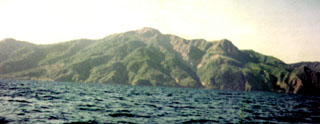Report on Paluweh (Indonesia) — 7 August-13 August 2013
Smithsonian Institution / US Geological Survey
Weekly Volcanic Activity Report, 7 August-13 August 2013
Managing Editor: Sally Sennert.
Please cite this report as:
Global Volcanism Program, 2013. Report on Paluweh (Indonesia) (Sennert, S, ed.). Weekly Volcanic Activity Report, 7 August-13 August 2013. Smithsonian Institution and US Geological Survey.
Paluweh
Indonesia
8.32°S, 121.708°E; summit elev. 875 m
All times are local (unless otherwise noted)
According to news articles, a partial lava-dome collapse at Paluweh on 10 August generated a pyroclastic flow that traveled N towards a beach village and killed at least 5 people. A volcanologist at the monitoring post for Paluweh noted that the eruption lasted seven minutes, and that the pyroclastic flow burned trees around the beach and villages, making it difficult to reach the victims. Pyroclastic flows continued to be reported hours after the initial eruption. Based on analyses of satellite imagery and wind data, the Darwin VAAC reported that an ash plume rose to an altitude of 4.3 km (14,000 ft) a.s.l. and drifted 130 km W.
News sources noted that a mandatory evacuation order had caused some residents to evacuate prior to the eruption on 10 August, but nearly10,000 still remained on the island. After the eruption, a rescue team was sent to evacuate about 2,000 people that remained inside a 3-km exclusion zone. A team member noted that rescuing people was difficult since they were reluctant to leave their livestock and homes, but also that the ground was hot and covered in 10-20 cm of ash. The VAAC reported that during 11-12 August ash plumes rose to an altitude of 1.8 km (6,000 ft) a.s.l. and drifted 110-130 km W. A news article noted that the eruptions were smaller on 12 August, but pyroclastic flows continued to be observed. The Alert Level remained at 3 (on a scale of 0-4).
Geological Summary. Paluweh volcano, also known as Rokatenda, forms the 8-km-wide island of Palu'e north of the volcanic arc that cuts across Flores Island. The broad irregular summit region contains overlapping craters up to 900 m wide and several lava domes. Several flank vents occur along a NW-trending fissure. The largest historical eruption occurred in 1928, when strong explosive activity was accompanied by landslide-induced tsunamis and lava dome emplacement. Pyroclastic flows in August 2013 resulted in fatalities.
Sources: Pusat Vulkanologi dan Mitigasi Bencana Geologi (PVMBG, also known as CVGHM), Darwin Volcanic Ash Advisory Centre (VAAC), Associated Press, CNN, Agence France-Presse (AFP), National Public Radio (NPR)

